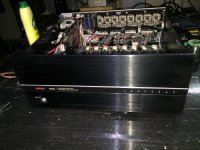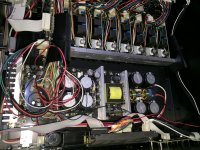Hello,
I am building a streaming amplifier with the following components:
Amp: LM3875 premium kit from Audiosector. Stereo, one rectifier. I believe his guide uses a 5A fuse.
Streamer: Raspberry Pi 3, IQ Audio DAC, 4" Waveshare screen all powered off of a MeanWell 15-5 PSU. I am not sure the total current draw, but I do not think it should be very high.
What type of inlet switch should I buy? I see all sorts: filtered, unfiltered, ones with the switch built into the unit, etc.
I live in Canada, any advice would be greatly appreciated!
I am building a streaming amplifier with the following components:
Amp: LM3875 premium kit from Audiosector. Stereo, one rectifier. I believe his guide uses a 5A fuse.
Streamer: Raspberry Pi 3, IQ Audio DAC, 4" Waveshare screen all powered off of a MeanWell 15-5 PSU. I am not sure the total current draw, but I do not think it should be very high.
What type of inlet switch should I buy? I see all sorts: filtered, unfiltered, ones with the switch built into the unit, etc.
I live in Canada, any advice would be greatly appreciated!
I use mini dual pole or triple 250v, 5 amp switches. Parallel the contacts to eliminate failure chance and lower the contact resistance.
The mini DPDT are panel mount and small. I use a three pole for overkill when I have one. Available with silver contacts. I use a panel mount separate fuse holder with this. And a ceramic fuse
A lot of the surplus switches I have are Alco brand. Never had a failure. Plus it only require about a 9/32 or so hole for mounting. Those rocker type are a lot more work to panel mount due to size and shape.
The mini DPDT are panel mount and small. I use a three pole for overkill when I have one. Available with silver contacts. I use a panel mount separate fuse holder with this. And a ceramic fuse
A lot of the surplus switches I have are Alco brand. Never had a failure. Plus it only require about a 9/32 or so hole for mounting. Those rocker type are a lot more work to panel mount due to size and shape.
The switch needs to be rated for use at the mains voltage. It should also be a type that can switch significant current (8-10 A at least) as the amp power supply will draw significant inrush current.
If you don't mind having the switch together with the power inlet, I'd go for a switched IEC inlet. Don't bother with the filter. Do make sure you fuse the mains connections - either by having the fuse in the IEC inlet, or by adding a fuse holder.
The inlets generally require a rectangular panel cutout. That's easily done by drilling a 4 mm hole in each corner of the cutout and cutting between them using a coping saw.
Alternatively, you can have a look at my Intelligent Soft Start (ISS). It allows for the use of a low voltage switch to control the mains voltage. It'll also interface nicely with a micro controller, if desired.
Tom
If you don't mind having the switch together with the power inlet, I'd go for a switched IEC inlet. Don't bother with the filter. Do make sure you fuse the mains connections - either by having the fuse in the IEC inlet, or by adding a fuse holder.
The inlets generally require a rectangular panel cutout. That's easily done by drilling a 4 mm hole in each corner of the cutout and cutting between them using a coping saw.
Alternatively, you can have a look at my Intelligent Soft Start (ISS). It allows for the use of a low voltage switch to control the mains voltage. It'll also interface nicely with a micro controller, if desired.
Tom
The switch needs to be rated for use at the mains voltage. It should also be a type that can switch significant current (8-10 A at least) as the amp power supply will draw significant inrush current.
If you don't mind having the switch together with the power inlet, I'd go for a switched IEC inlet. Don't bother with the filter. Do make sure you fuse the mains connections - either by having the fuse in the IEC inlet, or by adding a fuse holder.
The inlets generally require a rectangular panel cutout. That's easily done by drilling a 4 mm hole in each corner of the cutout and cutting between them using a coping saw.
Alternatively, you can have a look at my Intelligent Soft Start (ISS). It allows for the use of a low voltage switch to control the mains voltage. It'll also interface nicely with a micro controller, if desired.
Tom
Thank you for the response.
A switched IEC inlet seems like the ideal choice for me as I do not want to have a separate inlet and switch. Can you point me in the direction of one I can buy in Canada? I also do not want an illuminated switch.
Thank you,
Peter
I will be using this on a build here soon.
3Pin iec320 c14 inlet module plug fuse switch male power socket 10A 250V HV 747710244590 | eBay
Space is tight, and I don’t really like a busy setup.
3Pin iec320 c14 inlet module plug fuse switch male power socket 10A 250V HV 747710244590 | eBay
Space is tight, and I don’t really like a busy setup.
I will be using this on a build here soon.
3Pin iec320 c14 inlet module plug fuse switch male power socket 10A 250V HV 747710244590 | eBay
Space is tight, and I don’t really like a busy setup.
This is great, thank you.
I assume this is pretty much the same: Amazon.com: MXRS Inlet Module Plug 5A Fuse Switch Male Power Socket 10A 250V 3 Pin IEC320 C14 (3 Pack): Electronics
I am not familiar with all of the certifications, etc.
Thanks
Mouser P/N: 693-DC11.0001.001
Digikey P/N: 486-1073-ND
I'd shy away from buying electronic components for anything important on Amazon, eBay, etc. Sometimes you get good stuff. Sometimes you don't. Buy from distributors - Mouser, Digikey, Newark, etc. They'll happily sell to you.
Tom
Digikey P/N: 486-1073-ND
I'd shy away from buying electronic components for anything important on Amazon, eBay, etc. Sometimes you get good stuff. Sometimes you don't. Buy from distributors - Mouser, Digikey, Newark, etc. They'll happily sell to you.
Tom
Mouser P/N: 693-DC11.0001.001
Digikey P/N: 486-1073-ND
I'd shy away from buying electronic components for anything important on Amazon, eBay, etc. Sometimes you get good stuff. Sometimes you don't. Buy from distributors - Mouser, Digikey, Newark, etc. They'll happily sell to you.
Tom
Thanks Tom,
This is really helpful. Do you have a model number of something with a fuse holder built in that you would use?
I have the schurter 6090 (sold in the diyaudiostore kit) but I am hesitant on using it as it have two fuses and I read you shouldn’t ever fuse Neutral.
Thanks
This is great, thank you.
I assume this is pretty much the same: Amazon.com: MXRS Inlet Module Plug 5A Fuse Switch Male Power Socket 10A 250V 3 Pin IEC320 C14 (3 Pack): Electronics
I am not familiar with all of the certifications, etc.
Thanks
Hey there! I have had very bad luck with those 3-in-1 switches. I have this type on my Krell clone and it failed at least twice, its hard to measure what went bad since its all in one as you say. But maybe I just had a couple of bad ones? I will say that given my experience I will forgo the neat and cool 3-in-1 for separate inlet, fuse and switch.
...I read you shouldn’t ever fuse Neutral.
That "rule" is for In-Wall wiring.
Inside an "Appliance" it is legal to fuse Neutral. As-if you could even know which is which. (You have polarized outlets but they are frequently wired wrong.) Fusing both leads is OK and covers more troubles.
That "rule" is for In-Wall wiring.
Inside an "Appliance" it is legal to fuse Neutral. As-if you could even know which is which. (You have polarized outlets but they are frequently wired wrong.) Fusing both leads is OK and covers more troubles.
Thank you for the response. Is this true in Canada? Would it be better to just purchase a new 3-in-1 switch with one fuse?
Thank you
Unfortunately, shipping from the US to Canada is a lot more expensive than it used to be, but these guys have great stuff at great prices: Whats New at ApexJr
This is really helpful. Do you have a model number of something with a fuse holder built in that you would use?
Just jump on Mouser and search for "IEC inlet". Narrow it down to power inlets, and then use the filter function to include the features you want. Select a screw-mount type rather than a snap-in type. The snap-in types are pretty picky about the mounting panel thickness.
Tom
I couldn’t find any of them that had all three functions in one module when I looked on the Mouser and Digikey sites.
I won’t be using the switch much, and I suspect that’s what would die first.
Oh, also, my power consumption, and inrush will be a good bit less than a Krell I’m suspecting.
I won’t be using the switch much, and I suspect that’s what would die first.
Oh, also, my power consumption, and inrush will be a good bit less than a Krell I’m suspecting.
Last edited:
If you want fuse and switch in one IEC inlet and can't find one that you like, you can always put either the fuse or switch separate. I generally prefer to have the power switch on the front panel, for example. The trick there is to find a power switch that'll handle the inrush current. I know from experience that a 2 A rated switch won't survive the inrush current from a switching power supply more than a few times, for example. 🙂 That's in part why I use a solid state switch in parallel with a relay (and control the timing between the two) in my Intelligent Soft Start (ISS).
Tom
Tom
- Home
- Amplifiers
- Chip Amps
- Inlet Power Switch Choice


